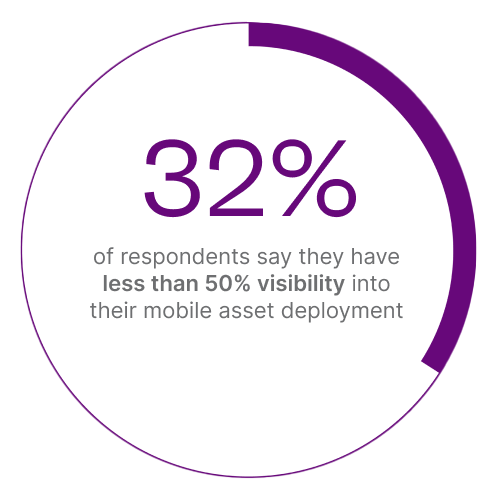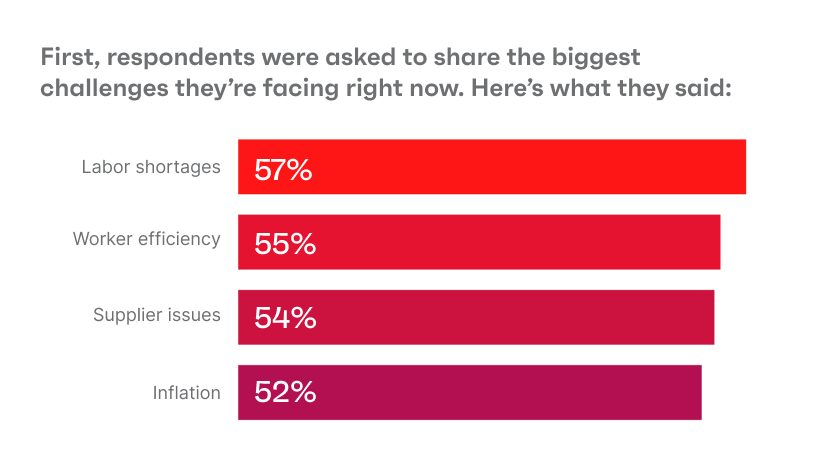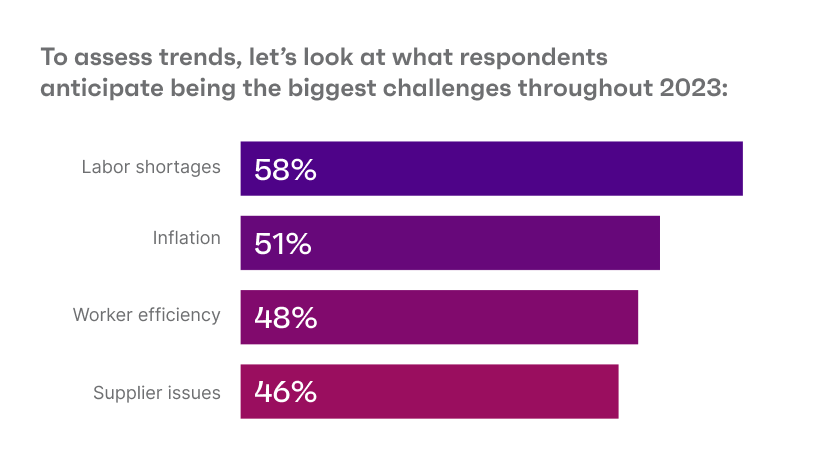The numbers you need to know
Concerns over labor shortages and inflation are fairly consistent—and significant. Time to train the workforce (52%) and high turnover (50%) were the most-noted workforce challenges. Additionally, 41% also cited the need for digital upskilling. It’s worth noting that all respondents – no matter their role and experience level – are concerned about labor shortages and other workforce issues, but the C-suite and VP-level are most concerned with workforce issues. Concerns about inflation and other economic issues are more prevalent among non-management-level workers.
There is promising news: respondents are becoming less concerned about supplier issues (46% versus a current rate of 54%). They’re also becoming less concerned about worker efficiency (48% versus a current rate of 55%).
That lessening concern is good news for many, and—especially in the case of worker efficiency—may be attributable to increasing adoption rates of mobile technology that enables efficient worker operations.
Embracing technology and automation
Around 85% of respondents plan to invest in new technology and/or build upon existing technology in the next year. More than half (53%) of respondents indicated they intend to increase automation up to 30% in the next year, and a quarter are aiming for an increase of 11-20%.
The most-used tools were hand-held mobile computers with barcode scanners (58%) and tablets (50%). Wearable computers and automated picking tools are currently less utilized but trending upwards, with respondents indicating that these tools are the top items they plan to invest in throughout the next year.
What’s preventing further acceleration of automation and technology adoption?
Budget is the biggest concern, cited by 65% of respondents. Change management came in second at 55%.
Tech that’s easy to deploy and is ultra-dependable could accelerate adoption. The survey says that reliability/uptime is the biggest consideration when evaluating new tech (69%), but other concerns are close behind: ease of deployment (67%), ease of learning (63%), and adaptability—characterized as a system that can quickly react to needed changes (63%).
What about visibility?
 About one-third (32%) of respondents say they have less than 50% visibility into their mobile asset deployment. That’s a concerning gap, because without visibility, organizations don’t have insights into how devices are being used, if they are working efficiently, or their security status, which increases vulnerability risk.
About one-third (32%) of respondents say they have less than 50% visibility into their mobile asset deployment. That’s a concerning gap, because without visibility, organizations don’t have insights into how devices are being used, if they are working efficiently, or their security status, which increases vulnerability risk.
Moreover, while the survey contained few outliers—speaking to the integrity of the results and the universality of concerns—a few elements stood out. For example, 19% of representatives from companies with more than 10,000 employees, and 15% of representatives from companies with 2,000 – 9,999 employees reported that they have zero visibility into their mobile asset deployment.
When further breaking down results by company size, labor shortage was the #1 challenge cited by all but one category: those with 2,000 – 9,999 employees. That group marked “worker efficiency” as the number one concern.
These results strongly suggest that once a company reaches a certain size (in this case, at least 2,000 employees), worker oversight becomes more challenging.
The takeaway: every company can benefit from a visibility solution that scales to account for its growth. This is especially important for companies that are —or aspire to be—at a size when manual granular visibility is prohibitively difficult.



 About one-third (32%) of respondents say they have less than 50% visibility into their mobile asset deployment. That’s a concerning gap, because without visibility, organizations don’t have insights into how devices are being used, if they are working efficiently, or their security status, which increases vulnerability risk.
About one-third (32%) of respondents say they have less than 50% visibility into their mobile asset deployment. That’s a concerning gap, because without visibility, organizations don’t have insights into how devices are being used, if they are working efficiently, or their security status, which increases vulnerability risk.